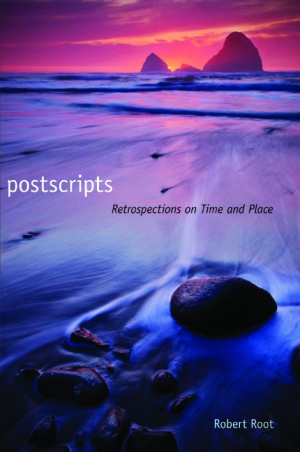
Postscripts
Retrospections on Time and Place
Hiking up to the summit of Cadillac Mountain in Maine, Robert Root carried a picture of Sanford Robinson Gifford’s mid-nineteenth-century painting The Artist Sketching at Mount Desert, Maine. In the picture, a lone figure sits on a rock, facing the Atlantic Ocean; a forest spans the lower part of the image from the mountain to the edge of the water. In his guidebook published in 1886, William Berry Lapham noted that the view from Cadillac Mountain was “grand—almost overwhelming,” writing that “the two grandest objects in nature, high mountains and a boundless ocean, here occupy the same horizon, and no earthly view can be more absorbing.”
The trip to Mount Desert is one of many that Root, an essayist and professor of English at Central Michigan University, describes in Postscripts. His purpose in climbing Cadillac Mountain is “to compare the picture with the actual site where it was painted.” The view from the top matches Gifford’s painting in beauty but not in detail; Root is unable to locate at the summit a boulder shown by the artist in the foreground of the picture and wonders “if it exists anywhere at all.” Root finds that the painting is part truthful rendering of Mount Desert and part invention, in keeping with John Ferguson Weir’s 1880 characterization of Gifford’s work as “poetic and reminiscent, not realistic in the formal sense” but “nature passed through the alembic of a finely organized sensibility.”
Root calls his essays “the nonfiction of place” and believes that such writing is successful if it moves the reader who is familiar with the locale to say “Yes, I know this place; this account is true to the place where I live.” For him, the descriptions must also “trigger in the reader unfamiliar with the setting a similar sense of having been there.” He travels, for the first time, to the region described by E.B. White in his essay “Once More to the Lake” and thanks White for making his trip seem like a return visit. Readers of Postscripts will similarly be grateful to Root for his lyrical descriptions of places around North America. They will be moved also by his reflections on time. A walk in Warren Woods, Michigan, makes him think about the timescale that applies to a forest. “Warren Woods,” he writes, “is a chronometer with extra hands that encompass in a single tick a human lifetime, a historical era, a century, hands circling the clockface on such a grand scale that no one has seen them move.” Through his essays in Postscripts, Root compels the reader to share his sense of humility in the face of an “enduring and unchangeable natural order.”
Reviewed by
Karunesh Tuli
Disclosure: This article is not an endorsement, but a review. The publisher of this book provided free copies of the book to have their book reviewed by a professional reviewer. No fee was paid by the publisher for this review. Foreword Reviews only recommends books that we love. Foreword Magazine, Inc. is disclosing this in accordance with the Federal Trade Commission’s 16 CFR, Part 255.
